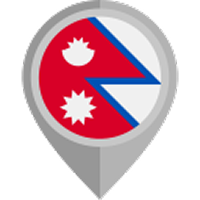Nepal vision | 22/08/2024
Trekking is fun for you. But now you want to take the thrill of the adventure of climbing a peak. Although, as a beginner, you might not want to go through the rigorous training to climb those challenging peaks.
What if we tell you there is a peak that is beginner-friendly? While it has its demanding ascent and descent, anyone with good physical fitness can do it.
The allure of the majestic Everest peak, Peak 41, Tangtse, Makalu, Kanchenjunga, Baruntse, and more, as well as the charm of the Sherpa culture and tradition, is the highlight of the journey.
So, let's just take time to explore all the things that make the Mera Peak worth it.
Overview of Mera Peak
The adventure starts with a scenic flight from Kathmandu Valley to the little hamlet town of Lukla. As you pass through the intriguing Sherpa villages, the lush forests of Sagarmatha National Park, and the cheering smiles of the majestic mountain peaks, you’ll be captivated by the surroundings.
The best part is that you can experience the magic of the iconic Everest trail in a sense of solitude and peace as it is a less crowded trail. Later, you take on the captivating wilderness of the Khumbu region and cross the Zatar La Pass (4,610m). Finally comes the challenge of the journey, which is the climb of Mera Peak (6,461m). While it does not have technical difficulties, it does present physical challenges.
The rewards of the climb are the panoramic views and the cheering smiles of Mount Everest (8,848m), Kangchenjunga (8,586m), Lhotse (8,516m), Makalu (8,485m), Baruntse, Peak 4, and Cho Oyu (8,201m).

What are the highlights of Mera Peak climbing?
- Take the time to experience the allure and thrill of reaching the summit of Mera Peak (6,461 m) and feeling a sense of accomplishment as you go through the test of physical and mental endurance.
- Be a witness to the majestic vistas of legendary Himalayan peaks, including Everest, Peak 41, Tangtse, Makalu, Kanchenjunga, and Baruntse.
- Walk through lush forests of rhododendrons and pine and observe the red panda, snow leopard, and Himalayan Thar, among the endangered diverse flora and fauna of Makalu Barun National Park.
- Experience the warm hospitality of the friendly local communities of Sherpa, Rai, and Limbu, known for their marvelous culture and unique perspective on remote mountain life.
- Despite being part of the Everest region, this trail is one of the less crowded, offering a sense of peace amidst the tranquil beauty of the Himalayan landscape.
- With little to moderate difficulty, Mera Peak is perfect for those with basic mountaineering skills.
How long does it take to climb Mera Peak?
Mera Peak climbing is a blend of thrilling climbing and magnificent trekking in the Khumbu region. Depending on the itinerary, the climb takes 16-18 days.
The first few days take you through the well-maintained trail and steep ascent of the forest and green pastureland.
Moreover, the trek takes you through altitudes covering more than 4,000m, so acclimatization is required. In the classic trek, you acclimatize to Khare, which gives you the chance to explore the aura of Mera Peak Base Camp and also time to adjust to the altitude.
In general, it takes 8-10 days to trek to Mera Base Camp, a day for acclimatization in Khare, summit climb from Khare to Mera Base Camp, and then descending the trek from Thuli Kharka to Lukla via Zatar La Pass.
Meanwhile, if you want to explore the remote region of Mera Peak, you can add a side trip to Mera Peak High Camp. It can also increase the days of your trek, but the rewards of the appealing majestic views of Everest and Makalu are just worth it.
Can beginners climb Mera Peak?
Yes, Mera Peak is more like a trekking hill. The Nepal Mountaineering Association has classified it as such, and it is located in the heart of the Mahalangur range of the Himalayas.
But it is one of the highest trekking peaks, standing smiling at the height of 6,461m. There are three main summits: Mera North, Mera Central, and Mera South. However, the expedition was done from the north part as the south was not visible on the map.
The regular route consists of little technical climbing. It is difficult because it combines trekking and climbing at a high and moderate elevation. It is one of the best ways to introduce trekkers to the essential mountaineering adventure.
What is the success rate of Mera Peak?
Mera Peak's trekking peak has a high success rate. The range from 90-95% is attributed to the moderately difficult peak. The essential factors for the success rate are the blend of acclimatization, the best weather, and the support of an experienced guide.
Besides, the success rate increases according to your preparation, physical fitness and the way to navigate the challenges during the climb
How do you prepare for Mera Peak?
There are ample things for you to prepare for a successful Mera peak climb: physical preparation, gear equipment, permit preparation, and the best time. So, let's take time to explore all of these things to have a successful expedition to the Mera Peak.
Permit
Two permits are required during the climb of Mera Peak: the Makalu Barun National Park permit and the Nepal Mountaineering Association permit.
- Makalu Barun National Park Permit: NPR 3000
- Nepal Mountaineering Association (NMA) Permit: There is a difference in the permit fees depending on the peak. When it comes to Mera Peak, the cost is
- Spring: NPR 4000
- Autumn: NPR 2000
- Summer: NPR 1000
- Winter: NPR 1000
Physical Training
For the initial phase of training, the first thing you should do is take the staircase and go out for a long walk. Then, you should start your workout. You should have the perfect amalgamation of cardio and strength training to provide stamina and energy.
On the other hand, it is better if you have previous experience with altitude. If possible, you can go on a short trek expedition that covers an altitude of over 4000m.
Gear
You should invest in a good layer of mid, outer and base layers. Along with that, you should have some essential climbing equipment like ice axes and crampons.
Take time to make a list of the required gear and pack it accordingly. Try to go light on packing. It is better if you rent the gear in the tourist hub in Thamel, as it can be suitable for the budget and packing lightly. 
Altitude Sickness
During the three weeks of the trek and two days of the Mera Peak climb, you can experience altitude sickness. To reduce this, you acclimatize in Khare for acclimatization. The time gives the adjustment for the body to adapt to altitude.
Moreover, they should carry medication like Damox to deal with altitude sickness. But if the situation becomes severe, it is advised to get help from a health professional to deal with serious conditions.
To wrap up, the climb to Mera Peak is a rewarding adventure with the perfect trekking and mountaineering experience. One of the highest trekking peaks, it has a moderate yet accessible ascent and marvelous views of the world's highest peaks.
With proper preparation and planning, anyone can easily reach the summit and get the deep sense of accomplishment that comes with it.
So, if you are ready to take on the adventure, feel free to contact me at Nepal Vision Trek. We are here to help you guide you through an unforgettable journey through the heart of the Himalayas.
FAQS









